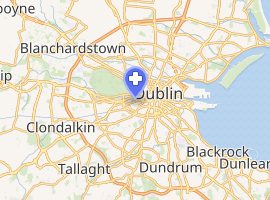St Patrick's University Hospital
St Patrick's University Hospital (Irish: Ospidéal Ollscoile Naomh Pádraig) is a teaching hospital at Kilmainham in Dublin. It is managed by St Patrick’s Mental Health Services.
| St Patrick's University Hospital | |
|---|---|
| St Patrick’s Mental Health Services | |
 St Patrick's University Hospital | |

| |
 Shown in Dublin | |
| Geography | |
| Location | Dublin, Ireland |
| Coordinates | 53.344208°N 6.292592°W |
| Organisation | |
| Type | Specialist |
| Affiliated university | Trinity College Dublin |
| Services | |
| Beds | 241 |
| Speciality | Psychiatric Hospital |
| History | |
| Opened | 1747 |
| Links | |
| Lists | Hospitals in the Republic of Ireland |
History
The hospital was founded with money bequeathed by the political pamphleteer, Jonathan Swift, following his death as "St. Patrick's Hospital for Imbeciles".[1] He was keen that his hospital be situated close to a general hospital because of the links between physical and mental ill-health, so St. Patrick's was built beside Dr Steevens' Hospital. The hospital, which was designed by George Semple, opened in 1747.[2]
In "Verses on the Death of Dr. Swift", the poet anticipated his own death:
He gave the little Wealth he had,
To build a House for Fools and Mad:
And shew'd by one satyric Touch,
No Nation wanted it so much:
That Kingdom he hath left his Debtor,I wish it soon may have a Better.[3]
Swift himself was declared of unsound mind by a Commission of Lunacy in 1742.[4][5] Will Durant said of him: "He went a whole year without uttering a word."[6]
Richard Leeper, who was appointed Resident Medical Superintendent in 1899, introduced a series of important initiatives including providing work and leisure activities for the patients.[7] Norman Moore, who was appointed Resident Medical Superintendent in 1946, introduced occupational therapy, including crafts and farm work to the patients.[7]
After the introduction of deinstitutionalisation in the late 1980s the hospital went into a period of decline.[8][9] In 2008 the hospital announced the expansion of its outpatient services to a series of regional centres across Ireland.[10] A mental health facility for teenagers known as the "Willow Grove Adolescent Inpatient Unit" opened at the hospital in October 2010.[11]
Services
The hospital, which is affiliated with Trinity College Dublin,[12] has 241 inpatient beds.[13]
References
- Jonathan Swift. Retrieved: 2011-11-23.
- Elizabeth Malcolm, Swift's Hospital: A History of St Patrick's Hospital, Dublin, 1746-1989 (Dublin, 1989), 32.
- Verses On The Death Of Dr. Swift, D.S.P.D. Written by Himself Occasioned by reading a Maxim in Rochefoulcault. November 1731.
- Mental Health History Timeline. Retrieved: 2011-11-23.
- The Gentleman's Magazine, Volume XLIII, P. 468. 1855.
- "The Story of Civilization", V.8., 362.
- Dunne, Bríd D. (28 November 2017). "A case study of the development of occupational therapy at St. Patrick's Hospital Dublin, 1935-1969". Irish Journal of Occupational Therapy. University of Limerick. 46: 31–45. doi:10.1108/IJOT-11-2017-0025.
- "After the Asylum". Irish Times. 13 July 2013. Retrieved 29 May 2019.
- Cotter, Noelle (2009). "Transfer of Care? A Critical Analysis of Post-Release Psychiatric Care for Prisoners in the Cork Region" (PDF). University College Cork. p. 5. Retrieved 29 May 2019.
- "St Patrick's unveils €300m mental health plan". Irish Times. 19 February 2008. Retrieved 6 May 2019.
- "Teen mental health unit opens". Irish Times. 1 October 2010. Retrieved 6 May 2019.
- "Courses". Trinity College Dublin. Retrieved 6 May 2019.
- "St Patrick's University Hospital". St Patrick’s Mental Health Service. Retrieved 6 May 2019.
Further reading
- Malcolm, Elizabeth (1989). Swift's Hospital: A History of St. Patrick's Hospital, Dublin, 1746-1989. Gill & MacMillan. ISBN 978-0717115013.